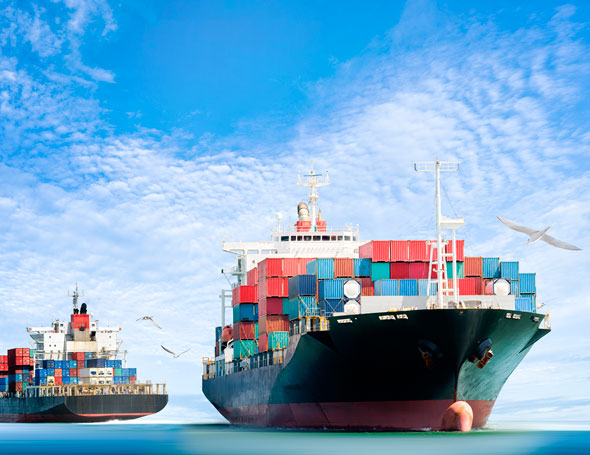In any branch of trade and industry, whenever goods are bought or sold, taking out transportation Insurance is an important act of business management.
But it is necessary that it be done right away so as to avoid huge losses.
The most interested parties in acquiring this class of insurance are:
- The owner of the cargo
- The mortgage holder
- The carrier
- The administrator of the contingent claim.
It is important to point out that, other than cargo owners or shippers, CARRIERS in general are obliged to take out insurance on the goods being transported, according to Decree-Law 73 of November 21st 1966 regulated by Decree 61.867 of July 12th 1967:
Responsibilities: Carriers in General
“Natural persons or legal entities, in public or private law, that take charge of cargo shipping, are obliged to take out liability insurance against loss and damage on cargo which they have been trusted to ship, under bill of lading.”
Thus, the mandatory insurance modalities for carriers are:
RCTR-C
RCTF-C
RCTA-C
RCA-C
RCOTM-C
RCTR-VI
RCF-DC (optional)


However, oftentimes, the owner of the cargo does not take out insurance because he believes the carrier is responsible for the integrity of the cargo.
The carrier does hold the obligation to take out liability insurance, but undoubtedly the insurance taken out by the owner of the cargo is more wide-ranging and specific to that type of cargo.
Besides, there is a school of thought according to which “the responsibility of whoever does the shipping, for the purposes of the liability insurance, only exists when there is guilt, that is, direct involvement in the damage”.
That is why it is best for both the shipper and the carrier to take out their own transportation insurances which, as a matter of fact, is still mandatory.
There are still international conventions to which the carriers are subject.
They can lead to refunds lower than the value of the goods being transported, which will result in loss for the owner of the cargo, in case of damage attributed to being the responsibility of the carrier.
In order to reduce the responsibility of this loss, one should look for protection through the shipping insurance.
It is the type of the purchase and sale contract that defines whether the responsibility of the insurance acquisition is that of the seller or the buyer of the goods, save different negotiations between parties.
The major types of purchase and sale contracts, used on trips abroad, mainly on maritime insurances, are:
Ex Works or EXW (from Production Site)
The seller delivers the merchandise to the importer at his premises and the buyer will then provide transportation and acquire insurance.
Free Alongside Ship or FAS
The seller’s obligation ends when the load is set alongside the ship, at the embarkation port. From then on, the buyer must bear all costs and risks of losses and damage to the goods, including those of stowage.
Free on Board or FOB
The seller takes the responsibility of hiring transportation and taking out insurance on the goods until it is loaded, which includes hoisting and stowing expenses. It is up to the buyer to pay for transportation and insurance from now on (merchandise on board).
Cost and Freight or CFR
The seller is responsible for getting transportation to final destination, and insurance on goods until it is loaded on board, which includes hoisting and stowing expenses. By this modality, the seller is supposed to hire freight to the destination port, and it is the buyer’s obligation to acquire insurance from the embarkation port to the final destination and load transportation from arrival port to final destination.
Cost, Insurance and Freight or CIF
It requires that the seller provide transportation and insurance to arrival port.
The transport portfolio is made up of insurance related to transported goods, that is, the insurance covers national and international trip risks as well as liability risks of carriers.
The transport insurance can be subdivided into sub-branches, according to the means of transportation used: maritime, land, fluvial or lake and aerial. In order to classify, the main means of transportation is taken into account, even when there are preliminary and/or complementary routes covered by other means.
The contract of transport insurance is, most of the time, posterior to two others:
Contract of Purchase and Sale (represented by the Invoice)
Contract of Transport of Goods (represented by Bill of Lading)
To transport goods, the buyer, when he is not the carrier himself, draws up a contract of transport (bill of lading).
The transport contract, in turn, can result in a third contract: the insurance contract, whose conditions are registered in the policy and in registrations.
This can be done even when there are no purchase and sale contracts and/or transport contract.
It is the case of goods transported in vehicles of the owner of the load without issuing of invoice.
The documents usually used in a Transport Insurance contract are: proposal, policy, endorsement, registration and invoice or monthly account.
Add to them the insurance certificate, used in international transport insurance – exports.
This certificate, whose aim is to prove the acquisition of insurance policy with financing banks, merchandise buyers or third parties with some interest in the goods, follows a standardized model and, in the case of an accident, it comes with procedure instructions in Portuguese and English.
